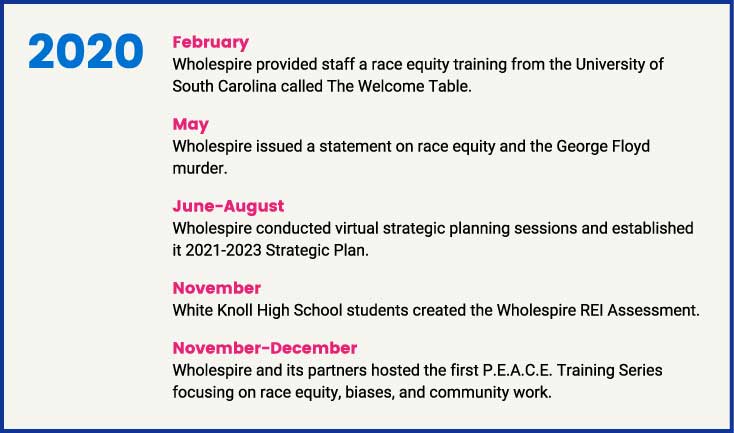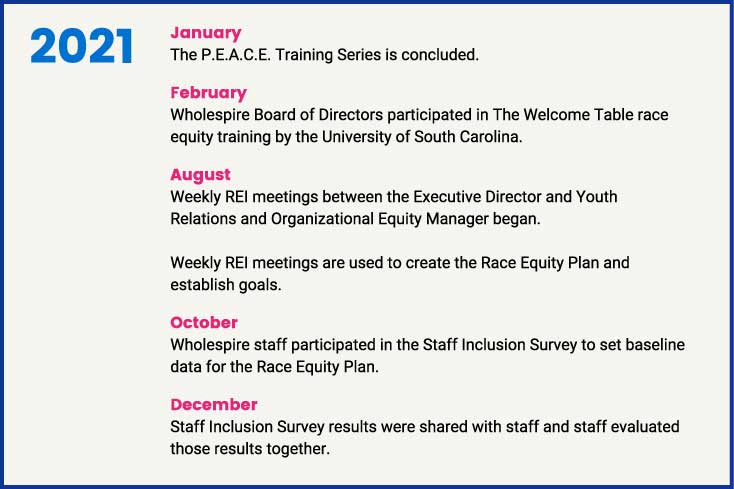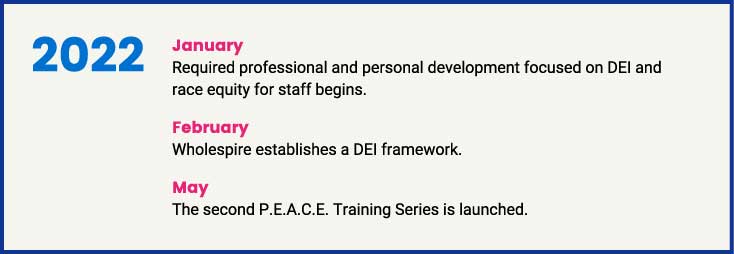
In my last blog, Getting Started with Race Equity in the Workplace, I briefly explained diversity, equity, and inclusion (DEI) and race equity and inclusion (REI) and why Wholespire is focusing on race equity in the workplace.
People of color experience inequities in the workplace in many ways. Here are a few examples that can show up in the workplace that may be more subtle than others.
- Raises, Promotions, and Other Income: Race to Lead’s 2019 survey of more than 5,000 nonprofit staff found that “While both white people and people of color are called upon to take on additional projects, people of color are less likely to receive raises, promotions, and bonuses compared to their white counterparts.”
- Equal Pay: According to the 2022 County Health Rankings National Findings Report, Black women will need to work 223 additional days beyond one year to earn the average annual salary of a white man and Hispanic women would need to work 299 additional days.
- A Sense of Belonging: In their study The Power of Belonging: What It Is and Why It Matters in Today’s Workplace, Coqual found, “Nearly one in three Black employees (32%) and one in four Asian employees (23%) say they have felt out of place at work because of their race or ethnicity–more than one in seven Latinx employees (15%) say the same.”
When issues like these in the workplace go unaddressed, it can exacerbate the overall disadvantages that people of color may experience. For instance, the 2022 County Health Rankings National Findings Report links advancing health for everyone to specific strategies that can be addressed through workplace equity.
Oftentimes, when speaking to partners about advancing race equity, many say that they don’t know how or where to start. Although there are many resources available on race equity, figuring out where to start and how to operationalize it within your organization can be tough. That’s why I’m going to tell you about our journey.
I want to start by reminding you that Wholespire has a history of prioritizing equity in our policy, systems, and environmental strategic work in communities by helping partners prioritize and address health disparities. Prior to establishing a strategic intention focusing on race equity in the workplace, we were taking steps to help staff and chapters better understand how to incorporate race equity into their work. The graphic below is a timeline of the external work that we were doing to advance equity.
Through awareness, collaboration, and planning, we eventually began to understand the need to be more intentional about how we operate as an equitable workplace.
Step One: Develop A Common Understanding

In 2020, we began our workplace efforts by making sure our staff, board, and partners had a common and basic understanding of equity. We started with training and activities to help all of us recognize and understand racial inequality and how we can address it.
First, our staff explored how our individual life experiences impact the ways we think and act. During three sessions of Welcome Table SC, Jennifer Gunter, Ph.D., interim director, Diversity, Equity and Inclusion
Director, Collaborative on Race, and Latesha Murray, co-facilitator for Welcome Table SC, led discussions to talk about and understand racial divisions that have hampered unity and social justice. The sessions offered a safe environment in which mutual respect, listening, and learning from one another were promoted. Our Board of Directors attended a similar training the following year.
Following training, we were inspired to share an opportunity with our partners and community coalitions to learn more as well. We partnered with the South Carolina Hospital Association and the South Carolina Office of Rural Health to launch the Promoting Equity Among Communities Effectively (P.E.A.C.E.) Training Series, coordinated by Zenger Strategies.
This three-part series was a special opportunity for various SC health coalition leaders to help their coalition members integrate racial justice concepts into their community coalition processes by introducing relevant, actionable tools and frameworks. Participants were able to collaborate and share knowledge, exchange ideas, and get a better understanding of race equity to better serve South Carolina.
We continue to provide DEI and race equity training opportunities to our staff, board, and community coalitions on an ongoing basis.
Step Two: Put it on Paper
We spent three months virtually collaborating, brainstorming, and hashing out the Wholespire 2021-2023 Strategic Plan. The deaths of Ahmaud Arbery, Breonna Taylor, and George Floyd and the early effects of COVID-19 happened in the months leading up to our strategic planning. During this time, it seemed as if everyone was talking about race equity, including us. This greatly informed our thinking during the strategic planning process.
As challenging as strategic planning might be, this one was especially crucial. Because equity was already a core value of Wholespire, we debated whether it should be specifically stated as a strategic goal. We wanted our strategic plan to include concrete steps toward advancing DEI with a focus on race equity, so we decided that including it would be the best approach. In my previous blog, I discussed why equity work should lead with race.
We also stated the tool we would use to steer our efforts would be The Promoting Race Equity and Inclusion (REI) in the Workplace Guide, a tool created by the Race Equity and Inclusion (REI) Partnership of South Carolina. I had the privilege of representing Wholespire on the REI Partnership and participating in the creation of this valuable tool.

Step Three: Complete an Assessment
We know the importance of assessments and we needed to find out how our organization was doing based on the 36 indicators in the REI in the Workplace Guide. But, we didn’t have an assessment tool.
With the assistance of some youth partners, we created our REI Organizational Assessment using the indicators found in the REI in the Workplace Guide. I’ll tell you more about our youth partners and why we chose to work with youth in my next blog post.
The race equity indicators from the REI in the Workplace Guide (for practitioners) are grouped into four levels:
- Personal Level, including biases both implicit and explicit.
- Interpersonal Level, including respect and relationships.
- Organizational Level, including workplace culture, norms, and policies.
- Community Level, including partners and funders.
After assessing ourselves, we found that we also needed to collect baseline data in other areas for future goal-setting:
- Staff inclusion survey – Assesses staff’s feelings of inclusion.
- Board member demographic survey – Assesses the demographics of Board members.
- Grant applicant demographic survey – Assesses demographic data of grant applicants.
- Funders equity focus group – Explores equitable grantmaking practices.
Step Four: Set Goals
According to Race to Lead, “Diversity, equity, and inclusion (DEI) efforts are becoming more frequent in nonprofit organizations and have raised awareness around issues of race and race equity. However, we found that this increased awareness is not translating into measurable change.”
At Wholespire, we felt it was very important for us to put our energy into REI efforts that would actually lead to change, so we identified goals and created an action plan. I began meeting weekly with our Executive Director to brainstorm and set goals based on the results of our assessments, current activities, and organizational capacity. The assessment results showed that we were doing satisfactorily in some areas of race equity, but we quickly realized there was work to be done in other areas. We knew that we could not address everything at once, so we had to prioritize while being flexible.
You’ll get more details about our goals and action plan in a later blog, but for now I’ll share the nine overarching goals. Keep in mind that most of our goals address only race equity, while others address both DEI and race equity.
- The Board and staff will complete professional development opportunities that promote self-awareness, personal growth, and a safe working environment with a DEI and race equity lens.
- Cultivate an organizational and workplace culture that fosters respect and relationships.
- Incorporate DEI and race equity into leadership strategies and tasks as part of regular operations.
- Implement and evaluate recruitment and hiring practices established during the previous year.
- Create the structure of the intern program (to increase the placement of students of color).
- Promote race equity norms and goals to ensure all staff at Wholespire feel valued and treated fairly.
- Review policies with a race equity lens and track and monitor race equity goals.
- Ensure meaningful participation from communities of color in all aspects of Wholespire’s operations.
- Promote equity as a standard in Wholespire’s direct and indirect grantmaking processes.
“Diversity, equity, and inclusion (DEI) efforts are becoming more frequent in nonprofit organizations and have raised awareness around issues of race and race equity. However, we found that this increased awareness is not translating into measurable change.”
Race to lead
Step Five: Track Progress
We are now tracking the progress of our race equity work by monitoring activities from our action plan. We achieve this in a variety of ways, including having staff add specific responsibilities to their individual work plans and conducting regular check-ins. During my weekly meetings with our Executive Director, we review the progress being made in our action plan by documenting status updates and next steps.
We will reassess ourselves at different points in time to see if there are changes in responses to the assessment and surveys. We’re still figuring out how to effectively coordinate and track progress on the action plan across the organization and will continue to fine-tune this process. Our plan is to work with an evaluator in 2023 to further evaluate our progress.
Step Six: Reflect/Evaluate

Now what? I think that is one of the most important questions we can ask ourselves during reflection or evaluation of our race equity goals.
Consider the composition of Wholespire’s Board of Directors. The number of individuals of color on our board increased from 1% in 2020 to 31% in 2022. Now what? In what ways should we evaluate the experiences of people of color on our board? How are we going to support and increase their participation? Are we creating an environment in which everyone feels safe and accepted? Asking questions such as these will help us develop our goals and strategies moving forward.
Much of this work for us was figuring things out as we go, and when speaking with others on this road, they’ve had to do the same. In moving forward, we are considering our best options and capacity to fine-tune our assessments, document our approach, and evaluate the results of our race equity efforts.
Even though there can be uncertainty when getting started with race equity in the workplace, we’ve taken some major steps given our small staff. We dedicated 40 percent of one full-time employee to this area of our work. We actively participate in local and statewide race equity workgroups, and we are strategically including DEI and race equity in all areas of our work.
In my next post, Part 4: How do you assess race equity in the workplace?, I’ll go over how we used various assessments to get a better understanding of where we were and where we needed to go.
If you want to learn more about how Wholespire is incorporating race equity in the workplace, visit our DEI webpage. It has complete information about our framework, as well as resources to explore. You can also find race equity resources on Options for Action.
Race Equity in the Workplace Series
Part 1: DEI Insights
Part 2: Getting Started with Race Equity in the Workplace
Part 3: 6 Steps to Advance Race Equity in the Workplace
Part 4: How do you assess race equity in the workplace?

